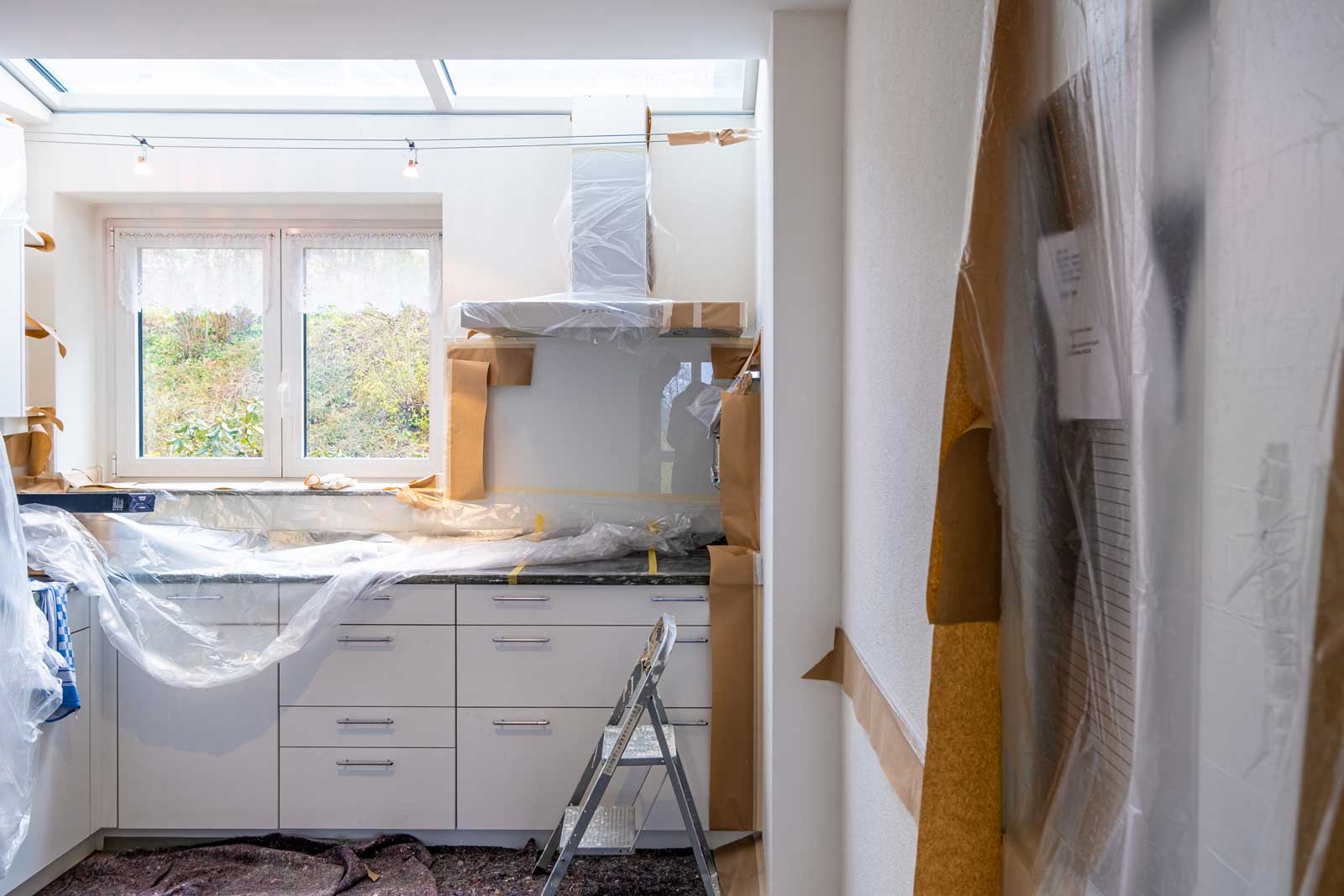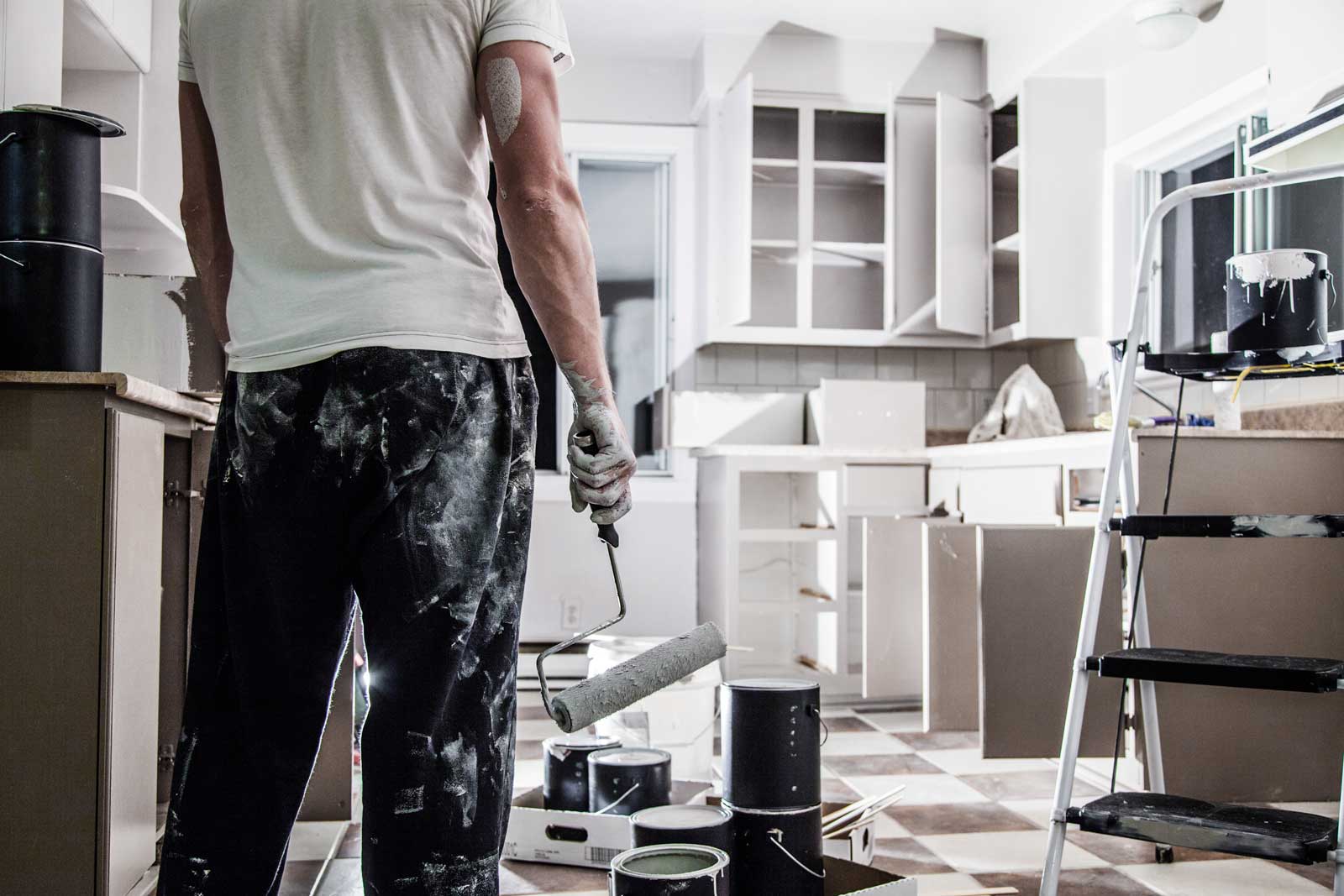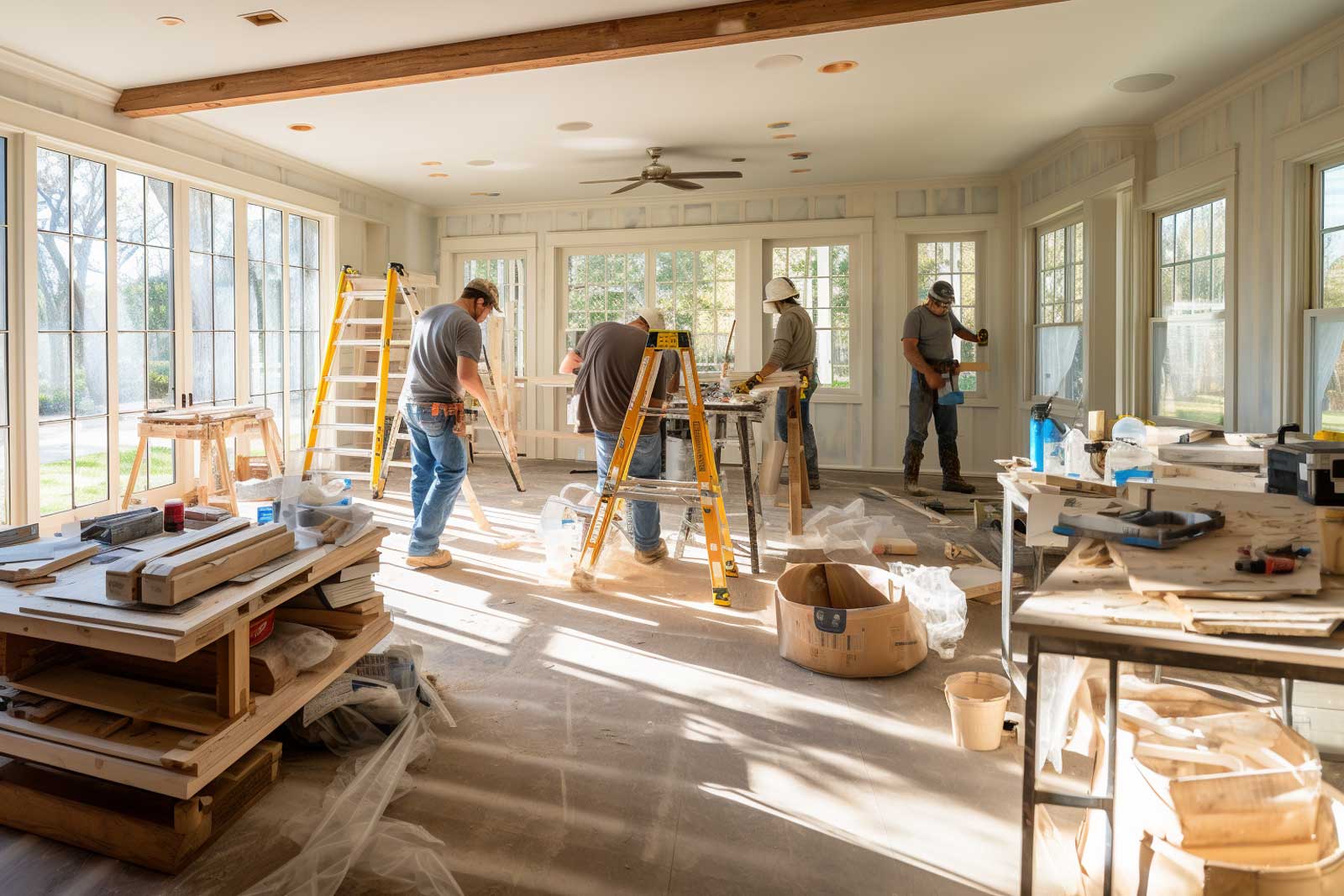Are you gearing up for a major home remodel? If so, you’re probably wrestling with one burning question: should you pack up and move out during the process? It’s a dilemma faced by homeowners who are facing any kind of substantial remodel.
So, what’s the verdict? The answer: You might just want to grab your suitcase. In this post, we’ll deep dive into the compelling reasons why moving out during a remodel isn’t just recommended, but might be the BEST decision you ever make.
But hang on, I know you’ve got questions. Like, isn’t it a hassle to find alternative living arrangements? And what about the costs involved? Or, can a remodel really disrupt daily life that much? What if it’s just a single room getting a facelift? How do you balance family’s needs while your kitchen turns into a construction zone? How does moving out accelerate project timelines?
So which one is the best option for you?

Reason #1: Direct Impact on Physical and Mental Health
When thinking about remodeling your home, it’s important to consider not only the exciting end result but also the impact the process may have on your health. This section will discuss the daily disruptions and health challenges related to home renovations and their direct impact on both your physical and mental well-being. Read on to understand how construction work can affect your life and why moving out during the process might be the best solution.
Daily Challenges: Noise, Restricted Amenities, and Living Amidst Construction
Imagine waking up every day to the sound of power tools and the constant noise of construction work. On top of that, your kitchen, bathroom, or other essential areas may be temporarily inaccessible during a remodel, making daily routines difficult. Moreover, living in a construction zone can cause extra stress and negatively impact your daily life.
- Noise: Persistent noise can disrupt sleep patterns and lead to increased stress levels.
- Limited access to amenities: A lack of access to necessary facilities such as cooking areas or bathrooms can lead to frustration and difficulty maintaining a healthy lifestyle.
- Living in a construction zone: The constant presence of workers, the clutter of materials, and the need to navigate around construction zones can disrupt your daily life and increase stress levels.
Health Risks: Dust Allergies, Old Toxins, and Stress-Induced Issues
Aside from the daily disruptions, remodeling can also expose you to potential health hazards. Dust, mold, and toxic materials can be uncovered during the renovation process, making moving out during the remodel a wise choice to maintain your well-being.
- Allergies due to dust: Demolition and construction work generates a lot of dust, which can exacerbate allergies and respiratory conditions.
- Potential exposure to old toxins or hazardous materials: Older homes may contain materials like asbestos, lead paint, or mold that can cause severe health issues when disturbed.
- Heightened stress levels: The remodel process can take a toll on your mental health, leading to increased stress levels which can cause health issues like high blood pressure.
As a homeowner, it’s crucial to consider how renovating your home could negatively impact you and your family. By recognizing the effect of the daily disruptions and potential health challenges, you can better understand the importance of finding alternate living arrangements during a remodel. This proactive approach can help mitigate stress and ensure a healthier living environment during the renovation process.

Reason #2: Better Efficiency For Your Remodeling Project
While planning a renovation project, you may struggle with deciding whether to move out or stay put during the process. This section will show you the perks of moving out during a remodel, enhancing the efficiency of the project, and reducing potential stress. Let’s dive into the key advantages of moving out during remodeling and how your project may benefit from it.
Quicker Work Progress: Vacant Properties Free from Family Routines
When you move out during a renovation project, it allows the workers to have full access to the work area without the regular interruptions of the family’s daily routine. There are several reasons why this can enhance the efficiency of the remodeling project:
- Uninterrupted work hours: Without having to worry about your family’s schedule, workers can work longer hours and tackle tasks more quickly.
- Faster decision-making: With the property owner easily accessible, decisions can be made faster leading to fewer delays in the project.
- No need for daily cleanup: The work crew won’t need to halt their work to clean up the work area to make it safe for family members at the end of each day. Instead, they can focus on completing tasks more efficiently.
By moving out during the remodeling project, you give the workers the freedom to work smartly and efficiently without compromising your family’s daily routine.
Preventing Delays: Keeping Kids and Pets Clear of Work Zones
A significant factor in enhancing the efficiency of your remodeling project is avoiding potential delays. Family members, especially young children and pets, can accidentally interfere with work areas, leading to delays and safety problems. Here’s how moving out during a renovation can eliminate these risks:
- No accidental damage: Family members and pets won’t inadvertently damage tools, equipment, or the ongoing work.
- Reduced chances for accidents: By not having young children or pets around, you lower the risk of accidents and injuries on the work site.
- No need to step out during critical tasks: You won’t have to interrupt your day to step out or away from the work area to allow for critical tasks to be completed.
So, by moving out during the remodeling process, you can save time, avoid potential delays, and ensure a smoother renovation experience for both your family and the working crew.
In conclusion, moving out during a renovation project can significantly enhance the efficiency of the tasks at hand and lead to a smoother, faster, and safer remodeling experience. Now that you understand the benefits, consider how this option may work best for your situation and plan accordingly.

Reason #3: Financial Considerations & the Hidden Costs of Staying
Considering a home remodel can be both exciting and intimidating. As you weigh your options, it’s important to consider the financial implications of staying in your home during the process. In this section, we’ll explore some hidden costs you might overlook and help you make an informed decision for your situation.
Extra Costs of Creating Makeshift Living Spaces at Home
When you decide to stay in your home during a remodel, it’s essential to create temporary living spaces to maintain your daily routine. For example, setting up a makeshift kitchen while yours is being renovated can be both pricey and time-consuming. You might need to purchase portable appliances, cookware, and even temporary countertops, as well as connect new plumbing for washing facilities.
If you have limited space, this could mean rearranging furniture, renting a storage unit, or incurring others costs to accommodate the temporary setup. These expenses can add up, so it’s important to factor them in when budgeting for your remodel.
Balancing Long-Term Costs: Staying In vs. Temporary Housing Expenses
It’s also important to consider the potential long-term costs of living in your home during a remodel. One such cost is the possibility of extended timelines due to interruptions and slower progress. When you’re living in the same space, contractors might need to work around your schedule or pause work to accommodate daily routines. Consequently, this can lead to delays and increased labor costs.
On the other hand, temporary accommodation like hotels, short-term rentals, or even staying with friends or family can pack a financial punch. This option, however, may come with some benefits – contractors can work uninterrupted, potentially completing the project faster and with fewer hiccups.
To weigh your options, create a cost comparison list like this:
- Expenses for setting up temporary living areas in your home
- Increased labor costs due to delays/scheduling conflicts
- Rent or hotel expenses for temporary accommodation
Keep in mind that the best choice depends on your unique situation, budget, and the scope and duration of your remodel project.
By understanding and anticipating these hidden costs, you can better prepare yourself for the financial considerations of staying in your home during a remodel. In the next section, we’ll discuss some simple yet effective ways to minimize these costs and make the most of your remodeling experience.
Expert Insights: What the Professionals Say
You might be wondering whether to stay in your home during a remodel or move out temporarily. Let’s hear from the professionals themselves and understand their point of view on this subject. In this section, we’ll dive into the opinions and suggestions of interior designers, project managers, and financial planners, as well as the importance of a well-coordinated timeline.
Expert Perspectives: Stay or Move During Renovations?
When it comes to the remodeling process, interior designers often recommend moving out for the sake of getting a fresh perspective on the space and avoiding the constant stress of living in a construction site. However, they also know that each project is unique and may sometimes be less intrusive to homeowners.
Project managers, on the other hand, understand that homeowners may have budget constraints and moving out could come with additional costs. In their opinion, it’s essential to evaluate the extent of the remodel and the condition of your home during the process. If you find it manageable and can maintain a safe and livable environment, staying put may be an option.
Financial planners weigh in on this decision by assessing the financial implications of moving out, such as temporary housing, storage fees, and additional travel expenses. They advise you to compare these costs with the potential downsides of staying, including delays, reduced work efficiency, and possible health concerns due to exposure to dust and debris.
Crucial Project Timelines: Insights from Experienced Contractors
A successful remodel largely depends on a well-coordinated timeline that outlines each phase of the project. Having a clear schedule in place can help you gauge:
- Length of the project
- Phases that may require you to vacate certain areas
- Manageable deadlines and expectations
Seasoned contractors emphasize the importance of communication and collaboration in developing a clear timeline. Here are some factors to consider when creating a timeline for your remodeling project:
- Project scope: Identify and prioritize the specific areas you want to remodel, setting goals for each phase.
- Budget: Determine the estimated costs for each aspect of the project, keeping in mind potential delays or unexpected expenses.
- Availability of professionals: Coordinate with interior designers, contractors, and any other stakeholders to ensure everyone is aligned and available during the project timeline.
Ultimately, the decision to move out during a remodel depends on the professionals’ advice, personal preferences, and unique project challenges. By considering the above factors and maintaining open lines of communication with your team, you can make an informed decision that best suits your needs and the success of your remodeling project.
The Specifics: What Areas of Your Home are Affected?
Imagine planning a home remodeling project and not knowing how it will affect your living space. In this section, we will dive into the different areas of your home that may be impacted during a remodel. This knowledge will provide you with a better understanding of what to expect, helping you make an informed decision about whether or not to move out during the renovation process.
Assessing Project Magnitude: Single Room vs. Kitchen vs. Total Renovation
The first step in determining the affected areas is to evaluate the scope of the project. Is it a single room, a kitchen remodel, or a complete gut renovation?
- Single room renovations, such as a bedroom or living area, may create minimal disruptions to your daily routine. However, these projects can still produce dust, noise, and limited access to the renovated space.
- Kitchen remodels often require significant alterations to plumbing, electrical systems, and cabinetry. This type of remodel typically results in limited or no access to your kitchen, which can be challenging for meal preparations and overall functionality.
- Complete gut renovations encompass multiple rooms or even the entire house. These projects can be highly disruptive, potentially making your home unlivable during the renovation process.
Considering the scope of the project will help you decide if moving out is necessary for the duration of the remodel.
The Difference in Experience When Remodeling Specific High-Traffic Areas Like Kitchens or Bathrooms
There’s no doubt that some spaces in your home are more crucial for day-to-day living than others. High-traffic areas like kitchens and bathrooms will likely cause the most significant disruptions when undergoing a remodel. Here’s what you can expect during renovations of these critical spaces:
- Kitchens: As mentioned earlier, kitchen remodels often involve substantial changes, making it difficult to prepare meals and utilize the space. You might have to rely on takeout or set up a temporary kitchen in another area of your home.
- Bathrooms: A bathroom remodel may limit access to showering, bathing, and other personal hygiene routines. Depending on the number of bathrooms in your home, this could range from a minor inconvenience to a significant disruption.
Overall, remodeling high-traffic areas like kitchens and bathrooms will create the most significant impact on your daily life. Evaluate the scope of the project and how important these spaces are to your routines to determine if moving out temporarily is the best decision for you. As you weigh your options, keep in mind how this remodel will affect not only your living space but also your day-to-day experiences.
Hearing from Those Who’ve Been There: Real-Life Experiences
Home renovations can be thrilling, but they can also be stressful. You may wonder whether it’s worth the hassle to stay in your current living environment during a remodel. In this section, we’ll dive into real-life experiences from those who’ve been there. We’ll share testimonials from homeowners regarding both options: living through the remodel process and temporarily relocating.
Homeowners Who’ve Lived Through a Remodel
Some homeowners choose to stay put during their home renovation, despite inevitable noise, dust, and inconvenience.
We did.
What a huge mistake that was.
Not only did we experience everything I’ve mentioned in this post, it felt like it was never – ever – going to end.
Everything was constantly covered in dust. Dirt was everywhere. And how many times can you step on a drywall screw barefoot without just completely losing your mind in frustration?
Our project easily took 3 times the amount of time it was supposed to take, but it was miserable at every single step, and if I had it to do over again, there’s no doubt in my mind that we’d have vacated while the work was going on.
As a homeowner, it’s crucial to weigh the pros and cons of each option when deciding whether to stay in your home or relocate temporarily during a renovation. By thinking through the input from those who’ve been through it, you can make a more informed choice that best suits your situation and overall well-being.
But Where Will Your Belongings Go?
You’ve decided to embark on a home remodeling project, and you’re excited about the transformation that awaits. But there’s one big question on your mind: where will your belongings go during the renovation? In this section, we’ll dive into the benefits of portable storage options during large-scale projects and how storage solutions can help maintain the quality of life amidst clutter.
The Benefits of Portable Storage Options During Large-Scale Projects
During a large-scale project, your home can quickly become overwhelmed with furniture, appliances, and personal items. This is where portable storage options step in to save the day. These include:
- Renting a storage container or unit
- Using a portable storage pod
- Collaborating with a professional moving and storage company
These options give you the flexibility to store your belongings temporarily while your home is being renovated, ensuring peace of mind and a clutter-free work environment for your contractors.
Not only do these storage solutions offer practical benefits, but they also provide you with extra protection for your belongings during the remodeling process—no more worrying about accidental damage or debris buildup around your treasured possessions.
The Challenge of Maintaining the Quality of Life Amidst Clutter, And How Storage Solutions Can Help
No matter how excited you are about your home improvement project, living amidst the chaos of a remodeling site can take its toll on your quality of life. Clutter increases stress levels and can even hinder productivity—a situation I can personally relate to when I once lived through a six-month kitchen remodel.
To combat this issue, consider the following storage strategies:
- Designate specific storage areas within your home for frequently-used items and valuables, making it easier to find things whenever you need them.
- Label and organize boxes to aid in the identification of items and streamline unpacking once the project is complete.
- Create temporary living spaces away from the construction zone to maintain a semblance of normalcy, such as setting up a makeshift kitchen or bedroom in another part of your home.
By leveraging these storage strategies, you’ll find it easier to maintain your sanity and quality of life during a large-scale renovation, ensuring a smooth transition into your newly updated space once the dust settles. With a solid plan for storage and organization, you can effortlessly navigate the complexities of a remodeling project and look forward to enjoying your beautiful, revamped home.
Preparation is Key: Getting Your Home Ready
Before diving into a remodel, it’s important to prepare both your home and yourself for the challenges ahead. Proper planning can save you time, money, and stress. In this section, we’ll discuss collaborating with contractors to understand your project’s timeline and making the best possible choices for your family’s needs and personal needs based on professional advice.
Collaborating with Contractors to Understand the Project’s Timeline
Working closely with your contractor is essential to obtain an accurate project timeline. The more you know about the estimated duration of each phase, the better prepared you can be to deal with any unforeseen circumstances. Here are some steps to help ensure a smooth collaboration:
- Communicate openly: Discuss your expectations and requirements with the contractor to make sure both parties are on the same page.
- Establish a schedule: Request a detailed timeline from your contractor that includes milestone dates, potential roadblocks, and contingency plans.
- Review progress regularly: Stay in touch with your contractor and schedule regular progress meetings to keep the project on track and address any issues that arise.
Understanding the project’s timeline will enable you to make informed decisions about whether you should move out during the remodel, and if so, for how long.
Making the Best Possible Choices for Your Family’s Needs and Personal Needs Based on Professional Advice
When deciding whether or not to move out during a remodel, consider your family’s needs and personal needs above all else:
- Identify your priorities: Determine which factors are most crucial for your family, such as budget, safety, and convenience.
- Evaluate your options: Weigh the pros and cons of staying in your home versus moving out temporarily, including costs and benefits.
- Consult professionals: Seek advice from your contractor and other experts to make the best decision for your situation.
For example, I remember when my sister embarked on a major kitchen renovation. With two young children, she chose to move out temporarily to ensure their safety and minimize disruption to their daily routines.
Considering the unique needs of your family members, pets, and personal circumstances, along with professional advice, will help you make the best possible choices during your home remodel.
As you continue with your remodel plans, keep in mind that preparation is essential for a smooth and successful project. From understanding the timeline to considering personal needs, thoughtful planning will go a long way in achieving your desired results.
At the end of the day the first thing you should do when you’ve signed the contract and are getting ready to start your reno project is to figure out how quickly you can get your family into a new home for the time being while your contractor works on your current home.






